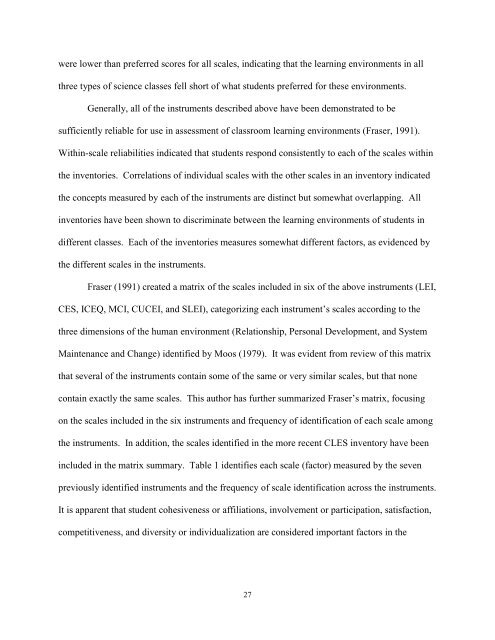STUDENT EVALUATION OF CLINICAL EDUCATION ENVIRONMENT
STUDENT EVALUATION OF CLINICAL EDUCATION ENVIRONMENT
STUDENT EVALUATION OF CLINICAL EDUCATION ENVIRONMENT
You also want an ePaper? Increase the reach of your titles
YUMPU automatically turns print PDFs into web optimized ePapers that Google loves.
were lower than preferred scores for all scales, indicating that the learning environments in all<br />
three types of science classes fell short of what students preferred for these environments.<br />
Generally, all of the instruments described above have been demonstrated to be<br />
sufficiently reliable for use in assessment of classroom learning environments (Fraser, 1991).<br />
Within-scale reliabilities indicated that students respond consistently to each of the scales within<br />
the inventories. Correlations of individual scales with the other scales in an inventory indicated<br />
the concepts measured by each of the instruments are distinct but somewhat overlapping. All<br />
inventories have been shown to discriminate between the learning environments of students in<br />
different classes. Each of the inventories measures somewhat different factors, as evidenced by<br />
the different scales in the instruments.<br />
Fraser (1991) created a matrix of the scales included in six of the above instruments (LEI,<br />
CES, ICEQ, MCI, CUCEI, and SLEI), categorizing each instrument’s scales according to the<br />
three dimensions of the human environment (Relationship, Personal Development, and System<br />
Maintenance and Change) identified by Moos (1979). It was evident from review of this matrix<br />
that several of the instruments contain some of the same or very similar scales, but that none<br />
contain exactly the same scales. This author has further summarized Fraser’s matrix, focusing<br />
on the scales included in the six instruments and frequency of identification of each scale among<br />
the instruments. In addition, the scales identified in the more recent CLES inventory have been<br />
included in the matrix summary. Table 1 identifies each scale (factor) measured by the seven<br />
previously identified instruments and the frequency of scale identification across the instruments.<br />
It is apparent that student cohesiveness or affiliations, involvement or participation, satisfaction,<br />
competitiveness, and diversity or individualization are considered important factors in the<br />
27












